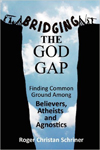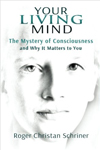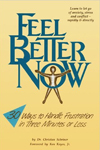I am attempting to explain why philosophers find consciousness puzzling, dealing with this issue in ways that non-philosophers can understand. Last Sunday I tried again:
The Mystery of Consciousness Unitarian Universalist Fellowship of Redwood City, August 9, 2015 © Dr. Chris Schriner 2015
“Is there any connection we could imagine to exist between certain movements of certain atoms in my brain on the one hand and, on the other hand, those facts that are basic, indefinable, and undeniable for me: ‘I feel pain, pleasure, I taste something sweet . . .’” – E. Du Bois-Reymond, 1872
“Nobody has the slightest idea how anything material could be conscious. Nobody even knows what it would be like to have the slightest idea about how anything material could be conscious. So much for the philosophy of consciousness.” – philosopher Jerry Fodor, 1992
Meditation:
Albert Einstein once said, “The most beautiful thing we can experience is the mysterious. It is the source of all true art and all science.” And of course one of the most mind-boggling mysteries of all is the fact that you and I have conscious experiences, experiences such as thoughts, perceptions, physical sensations, moods, emotions, dreams, and fantasies.
Today we’ll focus mainly on the qualities of sensory experience – the way coffee smells to you, the riveting pain of a toothache, the unique taste of butterscotch, the cool feeling of an ice cube against your skin, the quality of your experience of redness when you look at a ripe strawberry, and so on. Many of those who study consciousness find it very strange that the qualities of experiences would be states of a brain, and for over 20 years I have been obsessed with trying to solve this puzzle. I’ve read hundreds of articles and dozens of books on the subject, I’ve attended numerous conferences and colloquia and sometimes presented papers there, such as the Association for the Scientific Study of Consciousness just last month. So this morning I want to take you on a sensory and conceptual adventure about mind and body, focusing on the question of whether the qualities of sensory experience could exist within a brain. To prepare for these reflections we can meditate on one kind of sensory quality, the experience of sound. So I invite you to close your eyes, take a few deep breaths, and begin focusing on the sounds that you are experiencing, the sound of my voice and anything else that you hear. Notice the quality of each sound just as “a sound.” I’ll make some different noises while you focus on what your mind is doing with the air-waves that are bouncing off of your eardrums. [Rattle, bells, rainstick.]
Now ask yourself, “could these sounds, as I experience them, occur within my brain?” Could they be patterns of neural activity? And now take a few deep breaths and open your eyes when you’re ready.
The talk:
Woody Allen once remarked, “What a wonderful thing, to be conscious! I wonder what the people in New Jersey do.” But regardless of whether you’re from Manhattan, New Jersey, or anywhere else, it is wonderful to be conscious! Being conscious makes us quite different from teacups, snowflakes, lawnmowers, and those who disagree with us politically – but we struggle to say just what it is that makes consciousness special. What do you and I have that the average rock does not, and how would the rock have to change in order to wake up and have experiences?
This is important because the value of human life involves consciousness. Many of us would agree that it is wrong to needlessly destroy a conscious creature. By contrast, when I drink a glass of water I don’t think anything morally reprehensible happens to this liquid when it plunges into an acid bath in my stomach. I do not think the water is conscious, so I do not imagine it silently screaming, “Ahhhh!” – SSSSS! The difference in value between me and a glass of water involves the fact that I am conscious of pain and pleasure and it is not. Even pan-experientialists, people who believe that everything is conscious, often admit that human beings and other complex animals are conscious in a special way that gives us special value.
It has been maddeningly difficult to reconcile our understanding of consciousness with the way science thinks about the brain, and this has stirred up the old debate about how the mind relates to the body. There are several hotly-debated philosophical arguments that seems to show that consciousness cannot occur within the brain. Today I’m going to share some of these arguments against the idea that the conscious mind is in the brain, and one of them involves the story of Mary.
Imagine that we can peer into the distant future, hundreds of millions of years from now. Science, which today is only a few centuries old, has advanced so far in those millions of years that many fields of study are essentially complete. And biotechnology has expanded our memory and intelligence so that a single individual can understand everything there is to know about some complicated topic. One of these people is Mary, a neuroscientist who knows all that can ever be known about color experiences by studying their physical aspects. Mary has soaked up everything about the physical aspects of color perception that books, teachers, and computers can possibly tell her – but Mary has never seen a color. She grew up in a black-and white room, she was prevented from looking at her own skin, etc. Then one day she is released from her colorless home, free to see the whole range of hues for the very first time.
The story of Mary is a thought experiment proposed by a philosopher named Frank Jackson in 1982. Let’s say that the first colorful thing Mary sees is a garden full of dazzling red roses. So here is the crucial question: When she sees a red rose for the first time, does Mary gain new knowledge? Jackson claimed that she does, and he cooked up the Mary scenario because at that time he was a dualist. Dualists believe that mind and matter are two very different sorts of stuff, and Mary helped Jackson argue that mind is not matter. He claimed that after her release Mary gains new knowledge over and above the complete physical knowledge she already possessed. She learns what colors are as we experience them. So here is Jackson’s argument: If all things are physical, including our visual experiences, and Mary already knew everything about the physical aspects of color perception, then she would not have learned anything new when she walked into that garden. But if she did learn something new when she actually experienced color, then our experiences of color are not physical. They are not made of matter, and do not occur within the brain. And it does seem to many that when Mary saw those roses, she learned something new about the nature of color. In the past 30 years philosophers have responded to Jackson’s provocative one-page thought experiment with over one thousand scholarly papers and several books. Jackson himself eventually decided that his argument was flawed, but many believe he was right the first time and should never have recanted.
About the same time Jackson wrote about Mary, Joseph Levine proposed a puzzle called “The Explanatory Gap.” How could learning about the brain ever explain sensory qualities? They seem so different from patterns of neural activity. And how could we explain the fact that some brain event is one quality of experience instead of another? For instance, how could we ever know why a certain pattern of brain activity would turn out to be a reddish experience instead of a blueish experience? Or the experience of a bell-sound, or the distinctive fragrance of an agitated skunk? So even though Levine thinks experiences do occur within the brain, he doubts that we can ever explain how this is so. That’s the explanatory gap.
It seems as if neural activities and sensory experiences are two entirely different sorts of things, as if they belong in two different universes. Trying to use neuroscience to explain what colors, sounds, and pains are like when we experience them seems like trying to show how you could add up a column of numbers and get letters of the alphabet as your answer.
One more issue I’ll mention is what David Chalmers calls the Hard Problem of consciousness. David claims that even if we completely explained every function related to consciousness, everything that consciousness does, we would still fail to understand why the performance of these functions involves conscious experience. He even says it is conceivable that our brains could carry out all of their functions without having any experiences, and he highlights this problem by talking about an imaginary being that he calls a “philosophical zombie.” A philosophical zombie has a brain that is exactly like a human brain, and it acts just like we do, but the zombie has no experiences. If it screams due to touching fire, it is not actually feeling pain. If it says “yum” while eating ice cream, it does so without any taste-sensations. Even though this creature looks just like a normal human, inside the poor zombie’s brain all is dark, and all is silent. So if a zombie could, hypothetically, do everything we do without having experiences, why are we conscious? What’s the point? Was consciousness merely evolved so we could watch Dancing with the Stars?
So we have the Mary scenario, the explanatory gap, the Hard Problem, and philosophical zombies. After wrestling these problems for over 20 years I’ve come up with answers that give me some satisfaction, ideas about how consciousness could exist within the brain. Today I’ll suggest a way to deal with Mary in the rose garden, and the solution I’ll propose to that mystery also has implications for the other conundrums.
My basic approach is to say that we misjudge some aspects of our own experiences, and some of these misjudgments make us doubt that consciousness could live inside our heads. Because we are so intimately connected to our own sensory experiences, it may seem as if they are the things we know best. But the brain was not primarily evolved to inform us about our own minds. It’s mainly good at telling us what’s happening in the outside world and in our bodies. We do have some ability to detect our own emotions and moods, to know what we are thinking, and to reflect on the qualities of our experiences, but these are recently-evolved abilities and they’re not that well-developed.
I think we need to re-evaluate the strengths and weaknesses of introspection, and by introspection I just mean paying careful attention to one’s own stream of consciousness. So what is introspection good at, and what does it do badly? Well, we usually do pretty well at detecting sensory perceptions such as the experience of redness and noticing when those perceptions change. We are naturally skillful at monitoring these kinds of things by introspection, by looking within. But many scholars have thought that introspection also reveals the true nature of experiences, how they really are. They speak of having introspective access to the “metaphysical essence” of the color red, or the “ultimate ontology” of a toothache sensation.
I think this is a huge mistake. In fact I think that our own subjective judgments about the ultimate nature of experiences are almost worthless. For example, one might be good at knowing precisely when one’s experience of a toothache intensifies but utterly confused about the fundamental nature of this pain. Is pain a pattern of neural activities? Is it something that happens within an immortal soul? Is it spirit-energy or ectoplasm or who-the-heck-knows-what? Is it just an illusion? I don’t think introspection tells us much about this issue.
Here’s an example of a mistake about the ultimate nature of our own experiences. Based upon introspection, many people have claimed that intense pain always includes unpleasantness, meaning that there is something about the nature of agony that makes us want it to stop. But there’s a rare syndrome caused by strokes called pain asymbolia. “When burnt or pinpricked, asymbolics deny that their experience is unpleasant . . .” They show no sign of wanting to withdraw or cry out, but they say they are experiencing pain. They “experience a sensation which they identify as pain even though it is not intrinsically unpleasant . . .”
One woman had a lobotomy as a treatment for extreme chronic pain. When the surgeon followed up with her, years later, she said that the pain was still the same as before, but after the surgery it did not bother her. “In fact, it’s still agonizing” she said, “But I don’t mind.” “Similar experiences of pain without unpleasantness have been also reported by meditators and those in a hypnotic trance, e.g. during dentistry …” It is, of course, difficult to know whether the quality of the pain they experienced after treatment is the same as it was previously. What is clear is that these patients testify that they are experiencing states with a painful quality that is the same as or similar to pain states they have had before, and that these current pain states do not bother them.
(The above quotes are from Bain, D. “The Imperative View of Pain,” Journal of Consciousness Studies, September/October, 2011, Vol. 18, No. 9-10, pp. 164-85; and Fink, S. B. “Independence and Connections of Pain and Suffering,” Journal of Consciousness Studies, September/October, 2011, Vol. 18, No. 9-10, pp. 45-66.)
So introspection may seem to tell us that unpleasantness is obviously part of what pain is, but it is possible to have severe pain without having any impulse to avoid the pain. We thought introspection showed us something obvious about the essential nature of pain, and we were wrong.
Actually, looking within at our own experiences presents very ambiguous evidence about their true nature. Sensory phenomena do not wear little name tags that announce what kind of entity they really are. And it is just pitiful to see brilliant scholars flatly contradict each other about the “obvious” nature of experiences. Based on introspection, people have confidently said that conscious experiences are: non-physical, not located within space, constituted by a spiritual substance, part of a cosmic mind, part of the mind of God, or not divisible into smaller components. But for every scholar who asserts one of these ideas, there’s another who says, “That’s nonsense!” This crazy cacophony of conflicting opinions suggests that evidence from introspection about the nature of consciousness is ambiguous and unreliable.
This is one way to understand the puzzle of Mary. When Mary exclaims, “Aha! That’s what this red color is like,” it may seem as if she has encountered a new kind of reality that books could never have taught her. She experiences what redness IS. But if Mary cannot detect the ultimate nature of experiences by just focusing her mind on them, then she does not know that she has encountered some weird new something-or-other that science can never comprehend. All she can say is that she is now having an experience she has not had before. Her seeing red for the first time is no more discombobulating than if she were still locked in her color-free room and saw some particular shade of gray for the first time. Ho hum.
Perhaps you can see how this idea also applies to the explanatory gap. If we ask why some pattern of neural activity would constitute redness instead of blueness, people tend to think this question means: How can we explain why a certain brain event would be a strange and special something that is an experience of red instead of a strange and special something that is an experience of blue? If we aren’t good at knowing the true nature of our own perceptions, then we do not know that they are strange and special. We just know, “Oh, here’s that experience that I call, ‘seeing red.’ This experience tells me things about what I’m looking at. The traffic light looks red, so I’ll stop.” Since there’s nothing special and mysterious to explain, there was never an explanatory gap to begin with.
I admit that when I see red, hear a harp, or feel a throbbing headache, it sometimes seems as if I know the true nature of these experiences just by having them, but our personal intuitions about the nature of experiences have a miserable track record. One key lesson here is that in some ways we are too close to ourselves to know ourselves well. Trying to understand our own consciousness is like trying to see one’s own eye without using a mirror.
The philosophical puzzles of mind and brain can be solved with a big dose of humility, a willingness to say that how things seem to us may not be the way they really are. Careful reflection and analysis helps me realize this, but I admit that using logic is not always enough. If I want to open up to the possibility that the living human mind is actually embedded in the brain, it can also be helpful to use metaphor and poetry. So after all this philosophizing, I’ll close with some poetic imagery about the possible unity of mind and brain.
Metaphorically speaking, we could think of color experiences as neural narratives about the secrets of surfaces.
Experiences of sound constantly partition the vast vibratory silence that surrounds us.
Tastes and tactile sensations are experiential wizards, conjuring the unity of tongue and tabasco sauce, fusing our skin with the texture of silk.
Scents invisibly decorate the chemistry of air.
And what about light? If we have the gift of sight, we have light in our minds, and those poor philosophical zombies do not. But how can there be light within the darkness of our skulls? Again, poetically speaking, as you and I experience it – light is the brain’s brand of legible darkness – a luminous darkness that guides us through the night.




